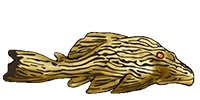| Scientific Name | Pterygoplichthys multiradiatus (Hancock, 1828) |
| Common Names | Orinoco Sailfin Catfish Sejlfinnet Sugemalle (Denmark), Vielgepunkteter Schilderwels (Germany) |
| Type Locality | [Probably near Santa Catalina, Orinoco system], Demerara, Guyana. |
| Synonym(s) | Ancistrus multiradiatus, Hypostomus multiradiatus, Liposarcus multiradiatus |
| Pronunciation | terry gop LICK thees |
| Etymology | Greek, pterygion, diminutive of pteryx = wing, fin + Greek, hoplon = weapon + Greek, ichthys = fish. Multiradiatus in reference to the number of rays in the dorsal rays (it was originally described as a species in Hypostomus, which normally has 8 rays in the dorsal fin). |
| Size | 500mm or 19.7" SL. Find near, nearer or same sized spp. |
| Identification | Pterygoplichthys can be identified by the number of rays in the dorsal fin. Ten or more dorsal rays (usually more than 10) indicates that it's a Pterygoplichthys. Most other plecos have 8 or fewer rays (in particular the larger Hypostomus species that are most likely to be confused with Pterygoplichthys). |
| Sexing | Comparison of the genital papilla in mature fish shows the differences in the sexes to the trained eye. In males this is a small yet thick stump which noticeably protrudes from the fish's undercarriage. In females it is less obvious and is recessed or lies flat with the body. |
| Distribution | South America: Orinoco River basin. Reported from Argentina. Introduced and established in Taiwan, mainland USA and Hawaii. Orinoco (click on these areas to find other species found there) Login to view the map. |
| IUCN Red List Category | Least Concern , range map and more is available on the IUCN species page. Last assessed 2020. |
| pH | 6.5 - 7.8 |
| Temperature | 23.0-27.0°C or 73.4-80.6°F (Show species within this range) |
| Feeding | Omnivorous and a good algae eater, especially when young. User data. |
| Suggested Tankmates | Almost any medium sized community fish. |
| Breeding | Unreported in captivity, in nature, the male fish occupies a tunnel in soft river bank in which the eggs are laid and guarded. The egg mass of bright orange eggs contains thousands of eggs. |
| Breeding Reports | There is no breeding report. |
| Reference | Zoological Journal, London v. 4, pp 246. |
| Registered Keepers | There are 12 registered keepers, view all "my cats" data. |
| Wishlists | Love this species? Click the heart to add it to your wish list. There is but a single wish to keep this species, see who wants what. |
| Spotters | Spotted this species somewhere? Click the binoculars! There are 3 records of this fish being seen, view them all. |
| Forum BBCode | |
| Search for P. multiradiatus | |
| Look up P. multiradiatus on AquaticRepublic.com | |
 | Look up P. multiradiatus on Fishbase |
 | Look up P. multiradiatus on Encyclopedia of Life |
 | Look up P. multiradiatus on Global Biodiversity Information Facility |
| LFS label creator ARN ref:1.4.6.1967 | |
| Last Update | 2025 Jan 01 12:10 (species record created: 2002 Sep 25 00:00) |





/siluriformes/loricariidae/pterygoplichthys/multiradiatus/1.jpg)
/siluriformes/loricariidae/pterygoplichthys/multiradiatus/2.jpg)